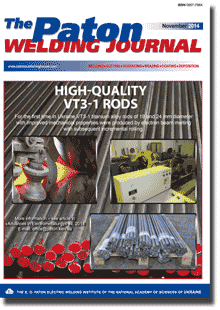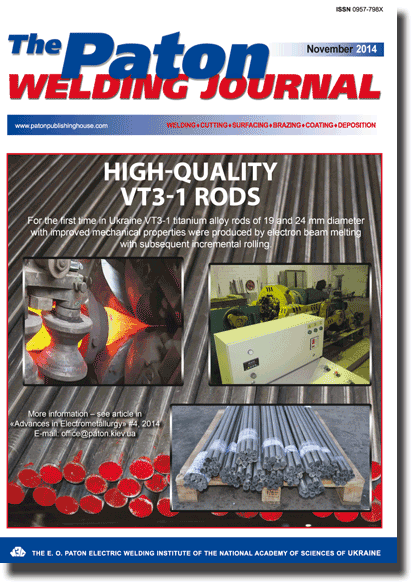| 2014 №11 (04) |
DOI of Article 10.15407/tpwj2014.11.05 |
2014 №11 (06) |

The Paton Welding Journal, 2014, #11, 28-31 pages
INVESTIGATION OF WEAR RESISTANCE OF COMPOSITE ALLOYS UNDER THE CONDITIONS OF GAS-ABRASIVE WEAR AT ELEVATED TEMPERATURES
A.P. ZHUDRA
E.O. Paton Electric Welding Institute, NASU. 11 Bozhenko Str., 03680, Kiev, Ukraine. E-mail: office@paton.kiev.ua
Abstract
Given are the results of laboratory investigations of wear resistance of composite alloys, based on fused tungsten carbides WC + W2C (relite), under conditions of gas-abrasive wear. Given is the technical characteristic of laboratory stand OB-876Ts for tests of deposited metal for gas-abrasive wear. The scheme of tests was developed, maximum corresponding to real conditions of service of parts during the effect of abrasive flow within the temperature range of 25-450 °C. It was established that wear of composite alloys bears a selective, cyclic character and does not essentially depend on properties and hardness of matrix at small attack angles. The application of tungsten carbide with spherical granules increases wear resistance of composite alloy, and the increase in temperature up to 400 °C considerably decreases it due to oxidation of carbide component of alloys. At room temperature the wear resistance of composite alloy 2.7 times exceeds the wear resistance of nickel carbide chromium alloy. 9 Ref., 3 Tables, 3 Figures.
Keywords: gas-abrasive wear, composite alloys, fused tungsten carbide, spherical granules, matrix, microhardness, plasma-powder surfacing, relative wear resistance, test stand
Received: 01.10.14
Published: 28.11.14
References
1. Tereshchenko, N.F., Gavrish, V.A. (1971) Resistance of alloys in gas-and-abrasive wear. Fiz.-Khimich. Mekhanika Materialov, 4, 18-21.
2. Yuzvenko, Yu.A., Zhudra, A.P., Frumin, E.I. et al. (1972) Peculiarities of gas-and-abrasive wear of composite alloys. Avtomatich. Svarka, 8, 35-38.
3. Yuzvenko, Yu.A., Zhudra, A.P., Frumin, E.I. (1973) Abrasive wear of composite alloys. Ibid., 7, 62-63.
4. Yuzvenko, Yu.A. (1978) Investigation and development of materials and technologies of mechanized open-arc surfacing: Syn. of Thesis for Dr. of Techn. Sci. Degree. Kiev: PWI.
5. Yuzvenko, Yu.A., Gavrish, V.A. (1972) Machine for assessment of wear resistance of deposited metal in gas-and-abrasive erosion. Avtomatich. Svarka, 6, 73-74.
6. Litvinenko, A.I., Zhudra, A.P., Bely, A.I. (2013) Analysis and kinetics of centrifugal spraying of ingots from fused tungsten carbides. Sovr. Elektrometallurgiay, 2, 29-36.
7. Dzykovich, V.I. (2009) Effect of the centrifugal thermal spraying process on properties of spherical tungsten carbide particles. The Paton Welding J., 4, 43-45.
8. Dzykovich, V.I., Zhudra, A.P., Bely, A.I. (2010) Properties of tungsten carbide powders produced by different technologies. Ibid., 4, 22-24.
9. Bely, A.I. (2010) Wear resistance and strength of tungsten carbides WC-W2C produced by different methods. Ibid., 12, 15-17.
Suggested Citation
A.P. Zhudra (2014) Investigation of wear resistance of composite alloys under the conditions of gas-abrasive wear at elevated temperatures. The Paton Welding J., 11, 28-31.The cost of subscription/purchase order journals or individual articles
| Journal/Currency | Annual Set | 1 issue printed |
1 issue |
one article |
| TPWJ/USD | 384 $ | 32 $ | 26 $ | 13 $ |
| TPWJ/EUR | 348 € | 29 € | 24 € | 12 € |
| TPWJ/UAH | 7200 UAH | 600 UAH | 600 UAH | 280 UAH |
| AS/UAH | 1800 UAH | 300 UAH | 300 UAH | 150 UAH |
| AS/USD | 192 $ | 32 $ | 26 $ | 13 $ |
| AS/EUR | 180 € | 30 € | 25 € | 12 € |
| SEM/UAH | 1200 UAH | 300 UAH | 300 UAH | 150 UAH |
| SEM/USD | 128 $ | 32 $ | 26 $ | 13 $ |
| SEM/EUR | 120 € | 30 € | 25 € | 12 € |
| TDNK/UAH | 1200 UAH | 300 UAH | 300 UAH | 150 UAH |
| TDNK/USD | 128 $ | 32 $ | 26 $ | 13 $ |
| TDNK/EUR | 120 € | 30 € | 25 € | 15 € |
AS = «Automatic Welding» - 6 issues per year;
TPWJ = «PATON WELDING JOURNAL» - 12 issues per year;
SEM = «Electrometallurgy Today» - 4 issues per year;
TDNK = «Technical Diagnostics and Non-Destructive Testing» - 4 issues per year.


